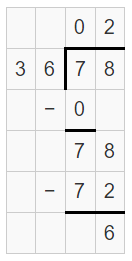The division is a basic arithmetic operation and it is the inverse of multiplication. The terms of division are dividend, divisor, quotient, and remainder. The number which we divide is known as a dividend, the number by which we divide is called the divisor. The quotient means the number of times a division is completed fully, and the remainder is the quantity that doesn’t go fully into the divisor. Here, we will learn about how to estimate the quotient of two numbers easily with solved example questions.
What is Estimating the Quotient?
When we divide two numbers, the result we get is called the quotient. The formula to express the terms of division is divided ÷ divisor = quotient + remainder. It is important to know how to estimate the quotient. Estimating the quotient means, we not doing the division for the actual numbers. You need to round off the dividend and divisor to the nearest 10 and proceed for the division to get the estimated quotient value.
How to Estimate the Quotient?
Check out the step-by-step process to calculate the estimating quotient of two numbers.
- If the numbers have two or more digits, then round off the numbers to the nearest 10 or 100 or 1000.
- And divide those numbers to get the quotient.
- The obtained quotient is called the estimated quotient of the given numbers.
Also, Read More Articles:
- Division of a Decimal by a Whole Number
- Divisibility Rules from 1 to 13
- Dividend Divisor Quotient And Remainder
Example Questions on Estimating the Quotient
Example 1:
Find the estimated quotient and actual quotient when 78 divided by 36.
Solution:
Given that,
dividend = 78, divisor = 36
divided ÷ divisor = 78 ÷ 36

Actual quotient = 2
Round off the divided and divisor to the nearest 10
new divided = 80, new divisor = 40
80 ÷ 40 = 2
Estimated quotient = 2.
Example 2:
A school track is 9.76 meters wide. It is divided into 8 lanes of equal width. How wide is each lane?
Solution:
The width of each lane is nothing but the quotient when we divide 9.76 by 8.
Round off the school track to the nearest 10 i.e 9.76 is 10.
Divide 10 by 8
10 ÷ 8 = 1
Approximately, 1 meter wide each lane.
Example 3:
Aerobics classes cost $153.86 for 14 sessions. What is the estimated fee for one session?
Solution:
The fee for one session is nothing but the quotient when we divide 153.86 by 14.
Round off 153.86 to the nearest 10 i.e 150
Round off 14 to the nearest 10 i.e 10
Divide 150 by 10
150 ÷ 10 = 15
Therefore, the estimated fee for one session is $15.
Example 4:
Estimate quotient when 1058 divided by 50.
Solution:
Round off 1058 to the nearest 100 i.e 1100
Divide 1100 by 50
1100 ÷ 50 = 22
The estimated quotient is 22.
FAQs on Estimating the Quotient
1. How can you use estimation to check if a quotient is reasonable?
- Round off the divisor and dividend to the nearest 10 or 100 depending on the number of digits.
- Divide the rounded dividend by divisor to get the estimated quotient.
- Compare the estimated and exact answers to check whether the answer is reasonable or not.
2. How do you estimate the quotients?
To estimate the quotients, you need to round off each number to the nearest 10 or 100 or 100 and then divide. The result is called the estimated quotient.
3. What is a quotient?
Quotient means the answer a division problem. In the divisor parts, you divide the dividend to get the quotient.
